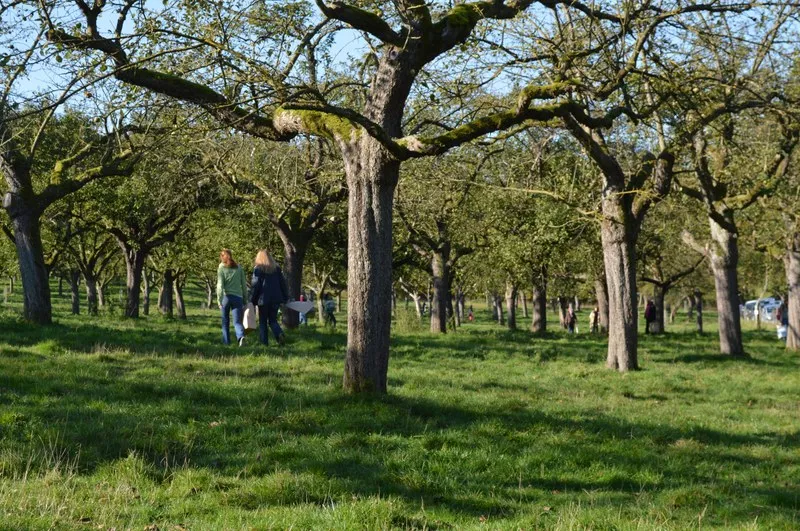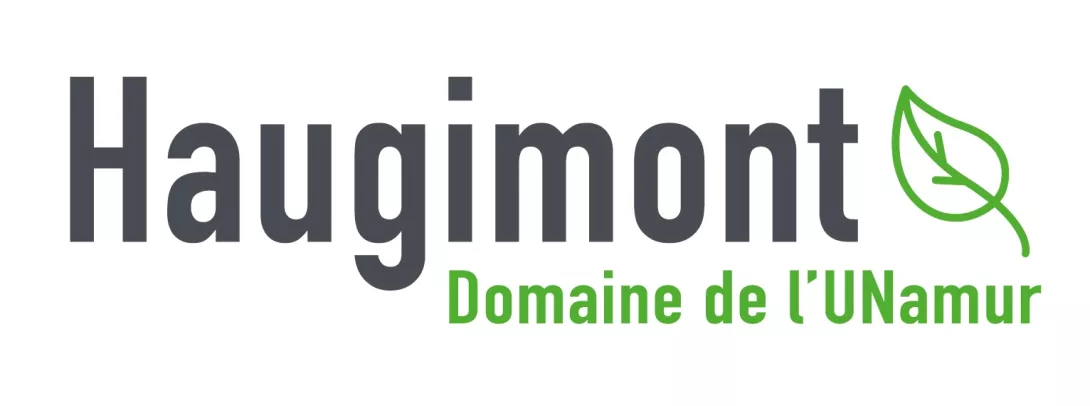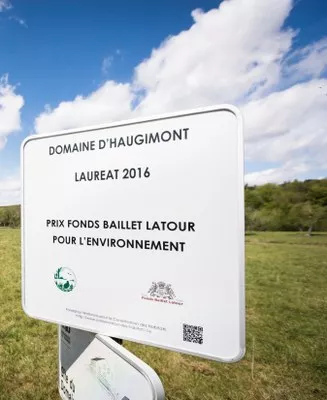The traditional Maraude d'Haugimont took place on 23 October 2022. This year, more han 700 people went to the estate to collect almost 5 tons of organic apples.
The day's programme included food trucks, apple picking, activities for children, information stands, and guided and commented walks.

In the morning, around thirty people took part in a forestry and historical walk to discover the Domaine's Geopark. The guides of the day were Isabelle Parmentier (Historian and Professor at UNamur) and Charles Debois (Forestry Engineer and former Manager of the Domain).
In the afternoon, about fifty people went on a guided tour of the large orchard to discover its history, its evolution (planting, pruning, grafting, grafting, biodiversity, heritage interest...) and the development of its fruits.
Each year, stands on the activities of the orchard are present on the Haugimont site:
- advice on planting and maintaining fruit trees,
- tastings of apple varieties via Diversifruit and the CRA-W,
- the valorisation of the fruits of the high-stem orchards thanks to the partnership with Reinette & Co
New this year, the orchard welcomed Go Transition Laine, an open group of citizens, inhabitants of the communes of Gesves and Ohey.
An exhibition on bees was also proposed by a beekeeper who runs an apiary on the estate.
Thank you to all the marauders for coming and contributing to the success of this event. We look forward to seeing you in October 2023 with even more activities on offer!


The University of Namur's sustainable rural campus
The sustainable campus is one of the 5 main objectives of the Univers2025 strategic plan.
The university must be exemplary in terms of sustainable development, in all three dimensions (economic, social and environmental), through the way it manages its infrastructures and assets for a "sustainable campus in form", as well as, as a teaching and research institution, through its commitment to actively contribute to the environmental transition "sustainable campus in substance". All of this is in line with the United Nations' Sustainable Development Goals (SDGs).
The Haugimont estate is an exceptional site belonging to the University of Namur. It is located in the heart of the Province of Namur in the superb Condruzian countryside.
Open to the public
In addition to the traditional annual marauding, the estate is open to the public and to schools for training, discovery and leisure activities (geo-tour, apple festival, sports races, etc.).
A 70-bed guesthouse is available for students on excursions to the estate, for staff members on a field trip and for external groups such as schools, scouts and others.
A place for teaching and research
The estate is also
- An outstanding teaching and research site for students and researchers in veterinary medicine (farm), geography (landscape observatory), biology and ecology. The Centre de Recherches Ovines, a flagship sheep farm in Wallonia, which plays a key role in the training of breeders.
- A place for training DNF agents in hammering, thanks to the installation of a "marteloscope" by the non-profit organisation Forêt Nature.
A forest estate
- Forest management is carried out according to the Pro Silva regime, which is close to nature and whose leitmotiv is to "imitate nature, hasten its work". The estate received the 2016 Environment Prize from the Baillet Latour Fund, awarded for its Pro Silva forestry management.
- 17% of the forest area is included in Natura 2000 with 2 ha of this area as a conservation island.
- The entire forest area is also included in the Site of Great Biological Interest (SGIB).
- Support for the "resilient forests" project launched by the Minister of the Environment with a view to accompanying the recruitment of spruce clearings so that the natural seedlings best adapted to climate change can develop.
- A hunting method that is more respectful of animal welfare, the silent stalking.
- A place for genetic experimentation by DEMNA for red oak and Douglas fir.
- The presence of a stand of ash seeds harvested for their high genetic value in terms of conformation for sewn timber.
- Short circuit: use of wood from the Haugimont estate in the carpentry for the construction of the new science building and for the cladding of the building housing the UNamur Life Sciences Technology Platform.
A place to promote biodiversity
In parallel with a reflection on how to integrate sustainable development issues into research activities, some projects aim to contribute to promoting biodiversity:
- Two apiaries were thus created in May 2022, one in the garden of the Carmel student residence in Jambes, the other at the Ovine Research Centre in Haugimont.
- Agri-environmental measures (MAE) are also carried out in favour of biodiversity in the meadows, such as
- mowing the land centrifugally and at a reduced speed
- maintaining refuges for small fauna (permanent piles of well exposed wood),
- conservation of the natural flora present on the edges of the plots and the slopes,
- maintaining good sunlight in ponds.
- - Measures in favour of biodiversity are also planned within the framework of the agreement with the CRA-W as part of the integration into the network of conservatory orchards, and involve installing
- nesting boxes (7 per 60 trees),
- facilities to accommodate useful wildlife (insect nesting boxes, wood piles, stone piles, ponds, etc.).
The Haugimont estate in a few figures
295
ha of woodland
56.5
ha of meadows and orchards
6
ha of parcs, yards and gardens
2.5
ha of ponds and puddles